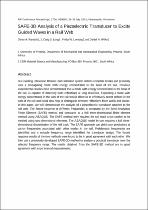 ResearchSpace
ResearchSpace
SAFE-3D analysis of a piezoelectric transducer to excite guided waves in a rail web
JavaScript is disabled for your browser. Some features of this site may not work without it.
- ResearchSpace
- →
- Research Publications/Outputs
- →
- Journal Articles
- →
- View Item
| dc.contributor.author |
Ramatlo, DA

|
|
| dc.contributor.author |
Long, Craig S

|
|
| dc.contributor.author |
Loveday, Philip W

|
|
| dc.contributor.author |
Wilke, DN

|
|
| dc.date.accessioned | 2017-02-23T09:56:01Z | |
| dc.date.available | 2017-02-23T09:56:01Z | |
| dc.date.issued | 2016-10 | |
| dc.identifier.citation | Ramatlo, D.A., Long, C.S., Loveday, P.W. and Wilke, D.N. 2016. SAFE-3D analysis of a piezoelectric transducer to excite guided waves in a rail web. In: AIP Conference Proceedings, 1706, 020005, 26-31 July 2015, Minneapolis, Minnesota | en_US |
| dc.identifier.uri | http://aip.scitation.org/doi/abs/10.1063/1.4940451 | |
| dc.identifier.uri | http://hdl.handle.net/10204/8940 | |
| dc.identifier.uri | https://doi.org/10.1063/1.4940451 | |
| dc.description | AIP Conference Proceedings, 1706, 020005, 26-31 July 2015, Minneapolis, Minnesota. Due to copyright restrictions, the attached PDF file only contains the abstract of the full text item. For access to the full text item, please consult the publisher's website | en_US |
| dc.description.abstract | Our existing Ultrasonic Broken Rail Detection system detects complete breaks and primarily uses a propagating mode with energy concentrated in the head of the rail. Previous experimental studies have demonstrated that a mode with energy concentrated in the head of the rail, is capable of detecting weld reflections at long distances. Exploiting a mode with energy concentrated in the web of the rail would allow us to effectively detect defects in the web of the rail and could also help to distinguish between reflections from welds and cracks. In this paper, we will demonstrate the analysis of a piezoelectric transducer attached to the rail web. The forced response at different frequencies is computed by the Semi-Analytical Finite Element (SAFE) method and compared to a full three-dimensional finite element method using ABAQUS. The SAFE method only requires the rail track cross-section to be meshed using two-dimensional elements. The ABAQUS model in turn requires a full three-dimensional discretisation of the rail track. The SAFE approach can yield poor predictions at cut-on frequencies associated with other modes in the rail. Problematic frequencies are identified and a suitable frequency range identified for transducer design. The forced response results of the two methods were found to be in good agreement with each other. We then use a previously developed SAFE-3D method to analyse a practical transducer over the selected frequency range. The results obtained from the SAFE-3D method are in good agreement with experimental measurements. | en_US |
| dc.language.iso | en | en_US |
| dc.publisher | AIP Publishing | en_US |
| dc.relation.ispartofseries | Wokflow;17803 | |
| dc.subject | Ultrasonic broken rail detection system | en_US |
| dc.subject | Semi-analytical finite element | en_US |
| dc.subject | SAFE model | en_US |
| dc.title | SAFE-3D analysis of a piezoelectric transducer to excite guided waves in a rail web | en_US |
| dc.type | Article | en_US |
| dc.identifier.apacitation | Ramatlo, D., Long, C. S., Loveday, P. W., & Wilke, D. (2016). SAFE-3D analysis of a piezoelectric transducer to excite guided waves in a rail web. http://hdl.handle.net/10204/8940 | en_ZA |
| dc.identifier.chicagocitation | Ramatlo, DA, Craig S Long, Philip W Loveday, and DN Wilke "SAFE-3D analysis of a piezoelectric transducer to excite guided waves in a rail web." (2016) http://hdl.handle.net/10204/8940 | en_ZA |
| dc.identifier.vancouvercitation | Ramatlo D, Long CS, Loveday PW, Wilke D. SAFE-3D analysis of a piezoelectric transducer to excite guided waves in a rail web. 2016; http://hdl.handle.net/10204/8940. | en_ZA |
| dc.identifier.ris | TY - Article AU - Ramatlo, DA AU - Long, Craig S AU - Loveday, Philip W AU - Wilke, DN AB - Our existing Ultrasonic Broken Rail Detection system detects complete breaks and primarily uses a propagating mode with energy concentrated in the head of the rail. Previous experimental studies have demonstrated that a mode with energy concentrated in the head of the rail, is capable of detecting weld reflections at long distances. Exploiting a mode with energy concentrated in the web of the rail would allow us to effectively detect defects in the web of the rail and could also help to distinguish between reflections from welds and cracks. In this paper, we will demonstrate the analysis of a piezoelectric transducer attached to the rail web. The forced response at different frequencies is computed by the Semi-Analytical Finite Element (SAFE) method and compared to a full three-dimensional finite element method using ABAQUS. The SAFE method only requires the rail track cross-section to be meshed using two-dimensional elements. The ABAQUS model in turn requires a full three-dimensional discretisation of the rail track. The SAFE approach can yield poor predictions at cut-on frequencies associated with other modes in the rail. Problematic frequencies are identified and a suitable frequency range identified for transducer design. The forced response results of the two methods were found to be in good agreement with each other. We then use a previously developed SAFE-3D method to analyse a practical transducer over the selected frequency range. The results obtained from the SAFE-3D method are in good agreement with experimental measurements. DA - 2016-10 DB - ResearchSpace DP - CSIR KW - Ultrasonic broken rail detection system KW - Semi-analytical finite element KW - SAFE model LK - https://researchspace.csir.co.za PY - 2016 T1 - SAFE-3D analysis of a piezoelectric transducer to excite guided waves in a rail web TI - SAFE-3D analysis of a piezoelectric transducer to excite guided waves in a rail web UR - http://hdl.handle.net/10204/8940 ER - | en_ZA |





